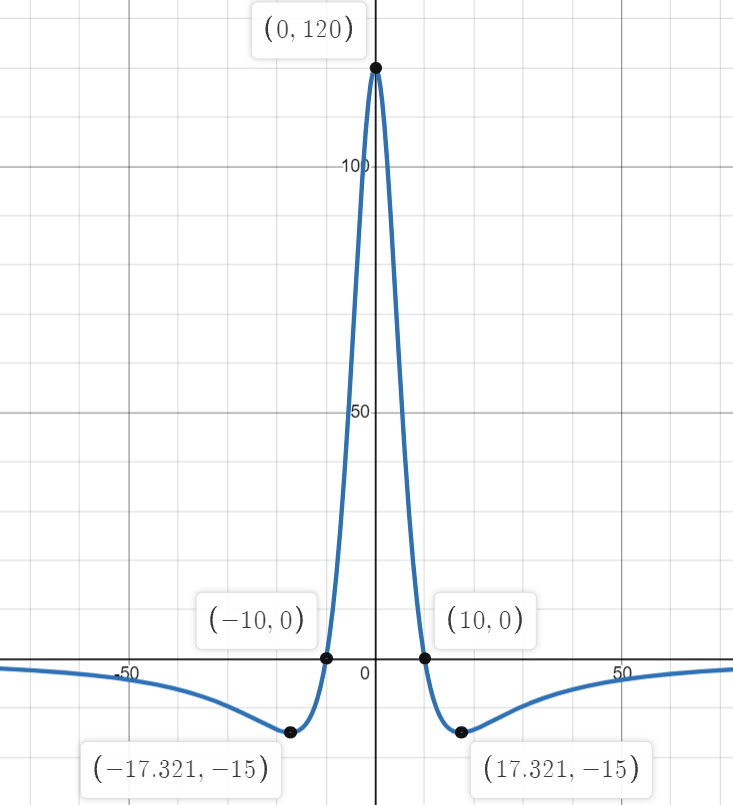Calculus: Early Transcendentals
8th Edition
ISBN:9781285741550
Author:James Stewart
Publisher:James Stewart
Chapter1: Functions And Models
Section: Chapter Questions
Problem 1RCC: (a) What is a function? What are its domain and range? (b) What is the graph of a function? (c) How...
Related questions
Question
The dropdwons that say "select" on part c and d is asking "is it increasing, decreasing or staying constant"

Transcribed Image Text:A culture of bacteria grows in number according to the function N(t), where t is measured in hours.
4t
N(t) = 300ol 1 +
t2 + 100
(a) Find the rate of change of the number of bacteria.
N'(t) =
(b) Find N'(0), N'(10), N'(20), and N'(30).
N'(0) =
N'(10) =
N'(20) =
N'(30) =
(c) Interpret the results from part (b).
At t = 0 hours, the bacteria population is --Select---
|---Select--
v. At t = 10 hours, the bacteria population is ---Select---
At t = 20 hours, the bacteria population is
v. And at t = 30 hours, the bacteria population is ---Select---
(d) Find N"(0), N"(10), N"(20), and N"(30).
N"(0) =
N"(10) =
N"(20) =
N"(30) =
Interpret what the answers imply about the bacteria population growth.
v. At t = 10 hours, the rate at which the bacteria population is changing is
At t = 0 hours, the rate at which the bacteria population is changing is ---Select---
| ---Select---
v. At t = 20 hours, the rate at which the bacteria population is changing is --Select---
At t = 30 hours, the rate at which the bacteria population is
changing is
--Select---
Expert Solution
Step 1
For (c),
Graph:

At t=0 hours, the bacteria population is constant. At t=10 hours, the bacteria population is decreasing. At t=20 hours, the bacteria population is increasing. And at t=30 hours, the bacteria population is increasing.
Step by step
Solved in 2 steps with 2 images

Recommended textbooks for you

Calculus: Early Transcendentals
Calculus
ISBN:
9781285741550
Author:
James Stewart
Publisher:
Cengage Learning

Thomas' Calculus (14th Edition)
Calculus
ISBN:
9780134438986
Author:
Joel R. Hass, Christopher E. Heil, Maurice D. Weir
Publisher:
PEARSON

Calculus: Early Transcendentals (3rd Edition)
Calculus
ISBN:
9780134763644
Author:
William L. Briggs, Lyle Cochran, Bernard Gillett, Eric Schulz
Publisher:
PEARSON

Calculus: Early Transcendentals
Calculus
ISBN:
9781285741550
Author:
James Stewart
Publisher:
Cengage Learning

Thomas' Calculus (14th Edition)
Calculus
ISBN:
9780134438986
Author:
Joel R. Hass, Christopher E. Heil, Maurice D. Weir
Publisher:
PEARSON

Calculus: Early Transcendentals (3rd Edition)
Calculus
ISBN:
9780134763644
Author:
William L. Briggs, Lyle Cochran, Bernard Gillett, Eric Schulz
Publisher:
PEARSON

Calculus: Early Transcendentals
Calculus
ISBN:
9781319050740
Author:
Jon Rogawski, Colin Adams, Robert Franzosa
Publisher:
W. H. Freeman


Calculus: Early Transcendental Functions
Calculus
ISBN:
9781337552516
Author:
Ron Larson, Bruce H. Edwards
Publisher:
Cengage Learning